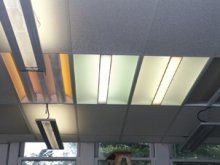| |
Issues experienced by 0-10V analog system
Since the control signal is of small analog voltage (0V to 10V), long wire runs
can produce a significant drop in the signal level resulting in different light
levels from different ballast/driver by the same controller. When the
dimming voltage is adjusted to minimum (like, 0V or sometimes at 1V), the light level
is also at minimum but is not completely turned off. Therefore, an extra pair of
wires is required to run from the panel to the 0-10V dimming ballast/driver so as to
turn the luminaire off, which consequently adds extra labour and materials to the installation costs.
Unlike 0-10V analog system, DALI is a digital system and thus does not suffer
from the above-mentioned 2 issues. Also each DALI device has on-board memory that stores all relevant
information (like, an unique address, and diagnostics function). The
bi-directional communication of a DALI luminaire/device allows the controller to query
and obtain information of its current status. More intelligence
is now built into the DALI ballast/driver, making less dependent on the
central controller to do all the work. If the central controller in 0-10V analog system breaks down, the
whole lighting system will not work. DALI controller is better in this sense, because it
only acts as an instruction-issue device most of the time. Therefore by having multiple controllers
in a DALI loop, their redundancies can substantially minimize the risk of breakdown
due to one central controller.
Compared with 0-10V analog system, DALI has the following advantages:
- Low Installation Cost
- Simple
- Low interference
- Interchangeable
Low Installation Cost
|
|
| |
Unlike 0-10V analog system, DALI does not need to run extra pair of wires to turn
off the luminaire. Saveing on labour and materials reduces the
installation cost substantially to the range of 40% to 50%.
This saving does not include the modification and addition of the luminaire/device
layout in the future.
There was a study done by Penn State
University Architectural Engineering Department on its laboratory of an area of
1200 square feet to control and dim 90 fluorescent fixtures. It was later
reported by the the magazine EC&M (Electrical Construction & Maintenance) in an article called
"DALI Takes the Lighting Industry Back to School".
In the article, Dr. Martin Moeck (Assistant Professor of Architectural Engineering at Penn State
University) said I was surprised to find out the cost of a conventional (proprietary)
0-10V DC analog fluorescent dimming ballast system was $45,500. The DALI system cost
$29,100 to install. After that, I cared about DALI.
|

|
|